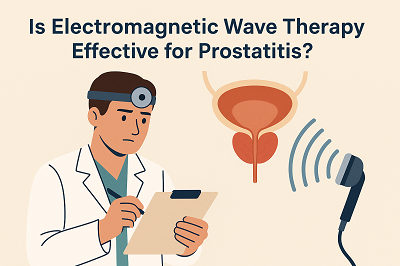Is Electromagnetic Wave Therapy Effective for Prostatitis?
Prostatitis is a common concern among men, and its treatment has long been a subject of heated discussion. In recent years, electromagnetic wave therapy—an emerging form of physical treatment—has gained increasing attention as an adjunctive option for managing prostatitis. But how effective is it really? What is its mechanism of action, and what limitations does it present? Let’s dive into the science and practicality behind this method.

How Electromagnetic Wave Therapy Works in Prostatitis Treatment
Thermal Effect Improves Local Circulation
Devices like shortwave and microwave therapy machines utilize electromagnetic waves to produce thermal effects on the prostate and surrounding tissues. This warmth helps improve local blood flow and accelerates the elimination of metabolic waste, which in turn relieves congestion and swelling of the prostate. Clinically, this improved microcirculation creates a more favorable environment for tissue repair.
Multi-Mechanism Relief of Inflammation and Pain
The thermal effect of electromagnetic waves also helps reduce the release of inflammatory factors, alleviating symptoms such as pelvic pain, frequent urination, and urgency—particularly in cases of chronic non-bacterial prostatitis. Additionally, this therapy increases the permeability of the prostatic capsule, enhancing the effectiveness of medications by helping them reach the affected areas more efficiently.
Multiple Delivery Routes and Standardized Procedures
Electromagnetic wave therapy can be administered transurethrally, transrectally, or through the perineum. In microwave therapy, for example, the patient empties the bladder and lies in a lithotomy or lateral position. A probe is gently inserted through the rectum or urethra to reach the prostate. Treatment power is generally set between 10–30 watts and lasts about 15–30 minutes per session. Sessions are typically conducted 2–3 times per week, with a full treatment course consisting of 8–10 sessions. Throughout the process, doctors monitor patient responses to ensure safety and comfort.
Limitations and Contraindications of Electromagnetic Wave Therapy
Cannot Eliminate Root Causes
While electromagnetic therapy may relieve symptoms, it cannot eradicate pathogens. In bacterial prostatitis, antibiotics or herbal formulations such as the Diuretic and Anti-inflammatory Pill are required to control the infection. Moreover, its effects are often short-lived—providing only temporary relief when used alone—and symptoms tend to recur if not combined with other treatments.
Limited Indications and Clear Contraindications
This therapy is primarily suitable for chronic prostatitis and can serve as a long-term symptom management tool or post-surgical recovery aid. However, it is strictly contraindicated in patients with acute infections, bleeding tendencies, or tumors. Unmarried or infertile men should also avoid thermal therapies due to potential impacts on sperm quality.
Risks from Equipment and Improper Operation
The effectiveness of this treatment depends heavily on the device and the practitioner’s skill. Since prostate size, location, and calcification vary among individuals, achieving even distribution of microwave energy is challenging. Misplacement of the probe or incorrect power settings can result in rectal or urethral burns, causing bleeding or hematuria. Home-use devices are generally underpowered and far less effective than professional equipment, so self-treatment is not advised.
How Traditional Chinese Medicine (TCM) Fills in the Gaps
TCM categorizes prostatitis into various syndrome types, each with targeted treatment strategies:
Damp-Heat Accumulation: Symptoms include burning urination, urgency, and frequent urination. Treatment focuses on clearing heat and eliminating dampness with formulas like Bazheng San—a blend shown to inhibit bacterial biofilm formation and reduce bladder inflammation.
Qi Stagnation and Blood Stasis: Manifested as perineal pain and urination difficulty, this type benefits from Qianlie Decoction, which improves microcirculation and reduces fibrosis. Ingredients like Tanshinone IIA inhibit fibrotic cell proliferation.
Kidney Yang Deficiency: Characterized by fatigue, cold extremities, and frequent nighttime urination. Yougui Wan, containing Rehmannia, Cornus, and Aconite, helps enhance testosterone and pelvic muscle strength via the HPG axis.
Yin Deficiency with Excess Heat: Symptoms include night sweats, premature ejaculation, and a red tongue. Zhibai Dihuang Wan helps balance Th1/Th2 cytokines and reduces proinflammatory markers like IL-6 and TNF-α. Anemarrhena saponins also inhibit abnormal epithelial proliferation in the prostate.
In particular, the Diuretic and Anti-inflammatory Pill—a proprietary Chinese herbal remedy made from Plantago Seed, Polygonum Aviculare, Talcum, Peach Kernel, Angelica, and more—offers a comprehensive solution. It works by:
- Clearing heat and detoxifying the body
- Promoting blood circulation and relieving pain
- Enhancing urination and reducing swelling
- Resisting hyperplasia, calcification, and fibrosis
- Unblocking glands and resolving follicular inflammation
This formula is well-suited for all types of chronic prostatitis and can be customized for individual patients to achieve targeted and effective treatment.
Conclusion
Electromagnetic wave therapy can play a helpful role in alleviating symptoms and improving post-surgical recovery for chronic prostatitis through thermal effects and improved circulation. However, it does not address the root causes of the condition and comes with limitations and potential risks. For a more comprehensive and sustainable treatment strategy, combining this modern physical therapy with Traditional Chinese Medicine—especially the Diuretic and Anti-inflammatory Pill—offers a scientifically sound and holistic approach to managing prostatitis.



